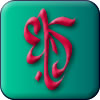Dr. C. George Boeree
Nearly all modern alphabets are descended from an alphabet invented 4000 years ago, probably by a group of people related to the ancient Hebrews, Phoenicians, and Canaanites, living in what is now the Sinai desert. They got the idea from the Egyptians, but used their own simplified pictures to represented consonant sounds. The Phoenicians and others of the region simplified the pictures further and often rotated them, but if you use your imagination, you can still make out where most of the 22 letters came from. If you turn the A with the point down, for example, you can see a representation of an ox head.
All the letters were for consonants, which is reasonable for Semitic languages like Phoenician, Hebrew, Arabic, and even Egyptian. Even aleph and ayin actually represent the glottal sounds that preceded the A's. Greek (and most other languages) desperately need to represent vowels as well, so they took a few of the consonants they didn't need, and turned them into vowels -- aleph being the obvious example. They then added a few symbols of their own to represent extra sounds they needed. Three unused letters were retained in the Greek numbering system.
The Phoenicians, like the Hebrews and Arabs today, wrote from right to left. The Greeks originally did the same, then changed to a system where they changed direction every line, and finally to the present system of left to right. This has passed down to all the modern European alphabets.
The Latin alphabet, ancestor of most western European alphabets, is derived from the Greek, but was also influenced by the nearby Etruscan version of the alphabet. Over the centuries, extra letters were invented by varying older ones, or reintroducing Greek letters such as K and Y. It wasn't until the middle ages that small letters came into being, usually based on more cursive versions of the capital letters.
The alphabets of south and southeast Asia are all derived from the Brahmi alphabet, which in turn is loosely based on the Aramaic. With a far greater number of consonants, the ancient Indians created many of their letters, and organized them phonetically. The creativity continued as the idea moved eastward, and many of the later alphabets bear little resemblance to the earlier ones (see below).
Another way in which alphabets have developed involves the creativity of one or two specific inventors. Examples incluid the pre-cyrillic alphabet glagolitic, and the alphabets for Armenian and Georgian:
The only independently invented "true" alphabet is the beautiful Korean hangul. One very noticable feature is that the letters are arranged to fit inside a "box". For example, la Korean word for honeybee (kkulbeol) is written as 꿀벌, not ㄲㅜㄹㅂㅓㄹ.
There are also a number of syllabaries (where each symbol represents a syllable rather than a single phoneme) that were independently invented, including two for Japanese, one for Cherokee, and one for the Cree and Inuit of Canada.
Writing Systems
Alphabets | Abjads | Abugidas | Syllabaries | Semanto-phonetic scripts | Alternative scripts | Undeciphered scripts | A-Z index | Index by writing direction | Q International Keyboard

Constructed scripts
For natural languages | For constructed languages | Colour-based | Tactile | Phonetic/Universal | Adapted | Fictional | Magical | A-Z index | Submit a con-script

Languages
Languages profiles | Language learning tips | Language lessons | Language names | Language families | Celtic languages | Articles | Language learning materials

Multilingual pages
Useful phrases | Silly phrases | Phrase Finder | Numbers | Time | Colours | Family words | Terms of endearment | Idioms | Proverbs | Tongue twisters | UDHR | Tower of Babel | Songs | Stories

What's new?
Languages: Kuria, Gusii, Tonga | Writing systems: Arleng | Constructed/Adapted scripts: Humaira, Karbi Mek'lek | Numbers: Gusii, Northern Sotho, Southern Sotho | Blog: Dawning, Rush Reeds, Quiz | Radio Omniglot: Fool, Salt, Sloom | Celtiadur: Knotty Bulges, Festive Feasts






















